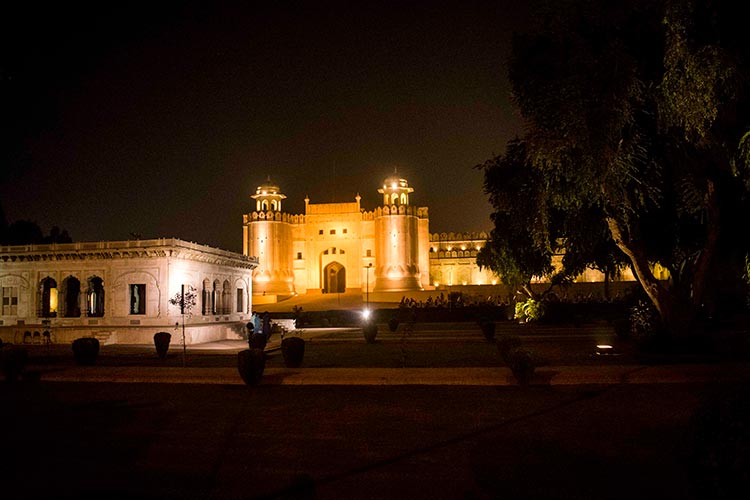Written by: Mahnaz Shujrah
Posted on: October 22, 2018 |  | 中文
| 中文
Sheesh Mahal illuminated and open for tourists at night
I walk around the khayabaan (walkways) and anhaar (waterways) until I reach the exact center of the Shah Burj Quandrangle of Lahore Fort. The Naulakha Pavilion is to my left and the cascade is on the wall behind me. I can almost hear the non-existent water that must have flowed here hundreds of years ago. Illuminated candles light up the pathways and my eyes follow them, until they reach the magnificent Sheesh Mahal, beautifully gleaming in the moonlit night. The sound of music echoes across the symmetric square and I can sense people walking behind the walls. I can hear a pair of anklets matching step with the beat of the tabla, on this clear, breezy autumn night.

There are some experiences which are truly unique to certain places. In Lahore, the "History by Night" tour arranged by the Walled City of Lahore Authority (WCLA) is one such experience.
Since its inception in 2012, WCLA has been actively working to promote tourism in the Walled City of Lahore. As some projects near completion and others remain underway, the hard work of WCLA and all partnering organizations is bearing fruit. Specifically, the ‘History by Night’ tour is an ambitious plan, which aims to open up the historic Lahore Fort for tourists at night. Issues like security and lack of proper management often tend to ruin such initiatives, but the authorities have made sure that this brilliant idea makes history more accessible to the common man.
Once the capital of the great Mughal Empire, Lahore is home to several historically significant monuments and architectural wonders. Often, these sites are seen as belonging to another era, and not considered relevant to us. However, ‘History by Night’ has brought the vibrant Mughal Lahore back to life. Launched by WCLA this past March, the tourists embark on a journey unlike any other. The tour starts at 7:30 pm each Saturday, from Roshnai Gate at the end of Food Street, Fort Road. The itinerary includes the tomb of Allama Iqbal, Baradari at Hazuri Bagh, Alamgiri Gate, Roshnai Gate, Samadhi of Ranjit Singh, Picture Wall, Sheesh Mahal and the Summer Palace of the Lahore Fort.
Even though I’ve been to the Lahore Fort countless times, the plan for the evening was still quite exciting, because most of these places are either off limits or restricted during the day, mainly due to the presence of large crowds. Thus, it would be my first time experiencing some of them at night. The other splendid aspect was the illumination of the Fort, indeed worth seeing as the building exuded a different aura after dark.
The tour was well organized, with the tourists divided into smaller groups led by trained guides. Throughout the journey, the guides served as windows to the past, explaining the significance of different structures. Rangeela Rickshaw rides and musical performances were included, making it all the more enjoyable. The star of the evening, no doubt, was the classical dancer at the Sheesh Mahal, Sunaina Khan. Her brilliant performance took everyone back to the time of the Mughals, and watching this revival of Kathak dance in the middle of the Fort, truly sparked our imaginations. The refreshments also served as a reminder that we were guests of the Emperor for the evening. The presence of royal guards and personnel, all in full costumes, further added to the experience, and the group needed to ask formal permission before entering each gate. There were many children in my group of tourists, and I could see their excitement as they waited to be granted permission from the Emperor. The tour concluded with a Meena Bazaar, where tourists were allowed to shop for traditional souvenirs.
What I loved about this idea was the interest it sparked amongst the audience, especially the younger generation. Reviving historic sites by breathing life into them is indeed a unique concept, and this tour is already attracting a lot of tourists from Lahore, Pakistan and beyond. However, this is only the beginning, and more can be done to make the tour even better. Slightly altered itineraries can cater to niche markets, such as researchers or children, and thus address their specific needs. As a student of history, I could see that many of the representations and recreations were not historically accurate, but served the purpose of entertainment. There is also a need for separate English language tours for foreigners, who were finding it extremely difficult to keep up with the Urdu of the guides. Lastly, to make the experience even more realistic, the excessive photography and filming by the organizers could be reduced.
Overall, the evening was one to remember for a lifetime, and I definitely look forward to more themed tours branching out from this initiative. If you haven't been a guest of the Emperor this season, book next Saturday night for an unforgettable journey.
You may also like: